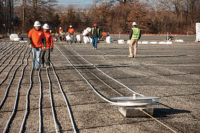Air Conditioning For Wet Heads

But there are some homes and businesses that, because they have hydronic or radiant heating systems, aren’t reaping the benefits of Carrier’s invention. It seemed their only option was cut to holes in their walls and add the ductwork needed for a conventional air-conditioning system.
But take heart, Wet Heads. You can put air conditioning into hydronic/ radiant offices and homes without committing to a major renovation.
Just ask Andy Stack, owner of Andy Stack & Sons, Avon, Ohio. He is completing the installation of a mini-duct air-conditioning system in a 10,000-square-foot, radiant-floor heated Lindahl cedar home in Port Clinton, Ohio.
“The design of the home did not allow for a clean installation of conventional forced air along with the radiant floor heating system,” Stack says. “When the homeowner came to our showroom I was able to demonstrate how comfortable, quiet and unobtrusive the Unico system is.” (For more information on Stack’s showroom, see “The Heat’s On” at www.PMmag.com.)
Hydronic Cooling
As radiant heat uses hot water to heat a room, the Unico air-conditioning system uses chilled water to cool the same space.Stack used three 4-ton chillers with four separate air handlers to provide 12 tons of cooling, sending chilled water throughout the whole house. “With Unico, I was able to divide the house into eight zones -- two Arzel zone systems per air handler,” he explains.
The Unico equipment was also better for the structure of the home, he says, because there wasn’t much room for conventional ductwork. Electronic air cleaners, Broan HRV ventilators and a snowmelt-system for the upper decks completed the project.
While he admits this system is probably more expensive than a conventional forced-air system, Stack says the paybacks are worth it -- lower energy costs, a comfortable home and a quiet system. And the bonus: The air handlers can be used for supplemental heating in the winter.
“This is the first summer the homeowner is using the chilling system, and he’s really happy,” Stack says.
Another central-air option is a SpacePak system, which can cool a home as well as a conventional system, says John Mottinger, president of J.C. Mottinger Associates Inc., a long-time rep of SpacePak.
“What is unique about the system is the ‘ductwork,’ which is really flexible 2-inch tubing that is run in walls and floors and around obstructions,” he explains. “So it can be used to retrofit any building with a wet heat system.”
SpacePak fan coils can be mounted in closets, attics or basements with a minimal amount of construction and mess, saving on labor costs. Conditioned air is delivered into the room through a small 2-inch opening. About 90 percent of the applications take advantage of existing space, he says; even the five-ton model is only 14 1/2 inches in height and can be placed in an attic through a 16-inch centered ceiling joist.
And it’s quiet; it uses sound-attenuating tubes that absorb noise and are used on each 2-inch supply run, Mottinger says.
Because the SpacePak system uses a little more than half of the air that conventional air-conditioning systems use, it removes 30 percent more moisture from the air.
“This dryer air results in better comfort conditions at higher temperatures and can yield savings to the owner on his utility bill,” he explains.
On average, the SpacePak equipment costs about 20 percent to 30 percent more than conventional equipment, Mottinger says, but homeowners will save on labor costs and energy bills.
Other Air-Conditoning Options
A twist on the hydronics concept comes from Invensys Energy Management. Chilled water is run through ceiling-mounted panels that exchange heat from the warm air in the room. The heated water is carried to a chiller, where it is cooled and returned to the ceiling.The system uses small ducts that directly feed in fresh air. The amount of air to be conditioned is reduced, thus cutting energy costs by 30 percent, the company claims.
Or you can go with a ductless split system. The Japanese invented the concept and brought it to the United States in the early 1980s, explains Sam Vivirito, sales manager for EMI’s Ductless Division. EMI was born in order to compete.
“This system is an alternative to central air conditioning,” he says. “It’s a ‘zone conditioner’ -- there is no need for ductwork, so it can fit into any space that needs cooling.”
The system consists of an indoor air handler and an outdoor condenser, interconnected by refrigerant tubing through a 3-inch hole in the wall. Decorative units can be mounted on the floor, wall, ceiling or recessed (dropped) ceiling.
Vivirito says the system can be a single zone with one condenser and one air handler, or a multizone system with one condenser containing numerous compressors connected to one, two, three or four air handlers. It can generate 9,000 Btus to 48,000 Btus, depending on the application.
And the applications are many: bedrooms, kitchens, family rooms, dining rooms, even room add-ons -- any space that needs to be cooled without adding ductwork.
“EMI’s ductless split system may cost a little more than a forced-air cooling system, but the payback is there,” he explains. “You’re only cooling the areas you want cooled. Since you’re not conditioning the whole house, you’re conserving energy.”
Ductless split systems first started in light commercial applications when the Japanese brought it to this country. But the residential market for this type of system is growing, Vivirito says, primarily because the public is becoming educated about it through the Internet, advertising and manufacturer literature.
Looking for a reprint of this article?
From high-res PDFs to custom plaques, order your copy today!





